
Carcharhiniformes, the ground sharks, are the largest order of sharks, with over 270 species. They include a number of common types, such as catsharks, swellsharks, and the sandbar shark.

Apristurus is a genus of catsharks, the family Scyliorhinidae, commonly known as the ghost or demon catsharks.
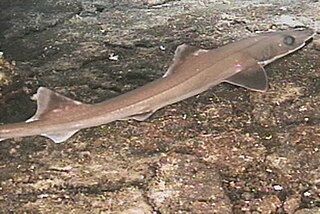
The slender smooth-hound or gollumshark is a species of ground shark in the family Pseudotriakidae. It is endemic to the waters around New Zealand, where it is usually found close to the bottom over the continental slope at depths of 300–600 m (980–1,970 ft). An extremely slim, plain brownish shark reaching 1.1 m (3.6 ft) in length, the slender smooth-hound can be identified by its broad, flattened head with a long, distinctively bell-shaped snout. Its mouth is angular with short furrows at the corners, and contains a very high number of tooth rows in both jaws. Its two dorsal fins are roughly equal in size.
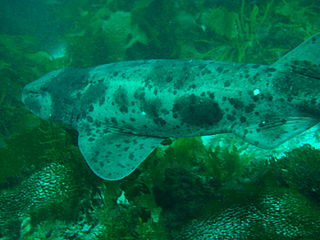
Cephaloscyllium is a genus of catsharks, and part of the family Scyliorhinidae, commonly known as swellsharks because of their ability to inflate their bodies with water or air as a defense against predators. These sluggish, bottom-dwelling sharks are found widely in the tropical and temperate coastal waters of the Indian and Pacific Oceans. They have stocky, spindle-shaped bodies and short, broad, and flattened heads. The mouth is capacious, containing many small teeth and lacking furrows at the corners. The two dorsal fins are placed far back on the body, with the first much larger than the second. Different species have various color patterns of saddles, blotches, reticulations, and/or spots. The largest members of the genus can grow over 1 m (3.3 ft) in length. Swellsharks prey on a variety of fishes and invertebrates, and are oviparous, with females producing egg capsules in pairs. They are harmless and have been deemed of having no commercial value.
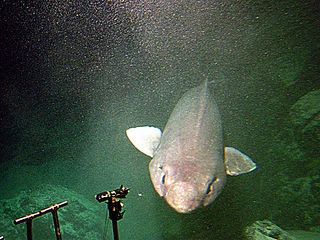
The false catshark or sofa shark is a species of ground shark in the family Pseudotriakidae, and the sole member of its genus. It has a worldwide distribution, and has most commonly been recorded close to the bottom over continental and insular slopes, at depths of 500–1,400 m (1,600–4,600 ft). Reaching 3.0 m (9.8 ft) in length, this heavy-bodied shark can be readily identified by its elongated, keel-like first dorsal fin. It has long, narrow eyes and a large mouth filled with numerous tiny teeth. It is usually dark brown in color, though a few are light gray.
The Pseudotriakidae are a small family of ground sharks, belonging to the order Carcharhiniformes, containing the false catsharks and gollumsharks. It contains the only ground shark species that exhibit intrauterine oophagy, in which developing fetuses are nourished by eggs produced by their mother.

The pygmy ribbontail catshark is a species of finback catshark, family Proscylliidae, distributed patchily in the western Indo-Pacific from Tanzania to the Philippines. It occurs around the edges of continental and insular shelves at a depth of 71–766 m (233–2,513 ft), typically on or near mud bottoms. One of the smallest living shark species, the pygmy ribbontail catshark grows to a maximum known length of 24 cm (9.4 in). It has a slender body with a low, ribbon-like tail fin, and is dark brown in color with blackish dorsal fin markings and tail bands. This shark feeds mainly on bony fishes, followed by crustaceans and then squid. It is aplacental viviparous with females bearing litters of 1–2 relatively large pups. It is of minimal significance to fisheries, being caught as bycatch in some areas.
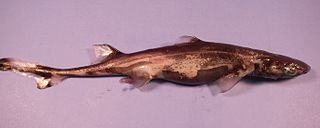
Etmopterus is a genus of lantern sharks in the squaliform family Etmopteridae. They are found in deep sea ecosystems of the Atlantic, Indian and Pacific Oceans.
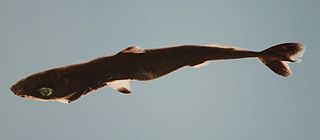
The spined pygmy shark is a species of squaliform shark in the family Dalatiidae found widely in all oceans. Growing no larger than roughly 28 cm (11 in), it is one of the smallest sharks alive, with this record beaten by the dwarf lanternshark. This shark has a slender, cigar-shaped body with a sizable conical snout, a long but low second dorsal fin, and an almost symmetrical caudal fin. Its sister species S. aliae and it are the only sharks with a spine on the first dorsal fin and not the second. Spined pygmy sharks are dark brown to black, with numerous bioluminescent organs called photophores on their ventral surface. The shark is believed to use these photophores to match ambient light conditions, which break up its silhouette and help the shark to avoid being seen by predators below.

The bristly catshark is a cat shark of the family Scyliorhinidae, found from southeastern India and the Andaman Islands, between latitudes 15° N and 5° N, at depths between 200 and 300 m. Its length usually ranges from around 20–26 cm, and it is regarded as the smallest catshark of Bythaelurus.
Bythaelurus is a genus of deep-water catsharks and part of the family Scyliorhinidae. The genus Bythaelurus Compagno 1988 was first described as a subgenus of Halaelurus Gill 1862 based on several morphological characteristics including a soft body with thin skin, a bluntly rounded snout without a pointed, knob-like tip, and eyes not noticeably elevated on the dorsal surface of the head. Members of this genus are generally found in deep water and have more somber body coloration.
The mud catshark or brown catshark is a species of catshark in the family Scyliorhinidae. It is found in Mozambique and Somalia. Its natural habitat is the open seas of the western Indian Ocean, from Mozambique to Somalia, between latitudes 13° N and 29° S, at depths between 340 and 765 m. It can grow up to 34 centimetres (13 in) long.
The jaguar catshark, also known as the Galápagos catshark, is a species of catshark from the Galápagos Islands. The species was first described in 2012. This catshark is about a foot long when mature, and it is colored blackish-brown with an asymmetrical pattern of light spots.
Planonasus is a genus of ground sharks in the family Pseudotriakidae, native to the western Indian Ocean.
Carcharhinus humani, also known as the Human's whaler shark, is a species of requiem shark, in the family Carcharhinidae. It inhabits the western Indian Ocean near the Socotra Islands, off Kuwait, Mozambique, and South Africa.
The narrowhead catshark is a catshark of the family Scyliorhinidae. This species is described based on one adult and one juvenile male specimen from off Tanzania and Mozambique in the western Indian Ocean. The species differs from its congeners by its slender head and snout, which is only slightly bell-shaped in dorsoventral view without distinct lateral indention. It further differs from B. clevai by attaining a smaller maximum size and having a color pattern of fewer and smaller blotches, larger oral papillae, a shorter snout, and broader claspers without knob-like apex and with a smaller envelope and a subtriangular exorhipidion. Compared to B. hispidus, the species has a longer snout, a longer dorsal-caudal space, broader clasper without knob-like apex, and fewer vertebral centra. In contrast to B. lutarius, B. tenuicephalus attains a smaller size and has a blotched coloration, numerous oral papillae, shorter anterior nasal flaps, a longer caudal fin, a shorter pelvic anal space, and shorter and broader claspers.
The pygmy false catshark, also known as the eastern dwarf false catshark is a species of ground shark, which lives in the Indian Ocean near Kochi, Kerala and off Sri Lanka. This species is one of two known members of its genus, the other being the dwarf false catshark which also lives in the Indian Ocean, but near Socotra. This had prior been an uncategorized species, but was recognized as a new species in 2019.









